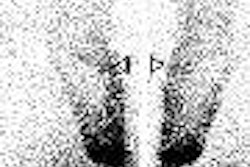SAN DIEGO - Imaging brain cancers with PET may benefit from the use of two separate tracers, F-18 FDG and O-(2-[F-18]fluoroethyl)-L-tyrosine (F-18 FET), in consecutive exams performed on the same day, according to a presentation at this week's Society of Nuclear Medicine (SNM) meeting. F-18 FET can assess protein synthesis within malignant lesions and identify both low- and high-grade gliomas, discriminating these from non-neoplastic lesions.
A team from the Research Centre Jülich in Jülich, Germany, and the University of Düsseldorf compared the accumulation of FDG and FET in patients with cerebral gliomas administered in one session. The researchers also sought to determine if FDG was a better agent for grading cerebral tumors.
The study included 28 patients with cerebral gliomas. The team performed PET scans 30 to 50 minutes after an injection of 180 MBq FET, then acquired a second PET scan 30 to 60 minutes after an injection of 240 MBq of FDG.
"The cerebral accumulation of FDG was calculated by decay-corrected subtraction of the FET scan from the FET/FDG scan," the authors wrote in their SNM poster presentation.
They noted that previously conducted phantom studies by the team demonstrated that errors introduced by the subtraction technique were negligible. They used a region of interest (ROI) analysis to calculate the mean tumor-to-brain ratios (TBR) for FET and the mean tumor-to-cortex ratios (TCR) for FDG. The group then classified the gliomas as FET-positive if they had a TBR greater than 1.6 and as FDG-positive if they had a TCR greater than 0.7. The imaging results were then compared with histological results.
Histology on the patient cohort revealed 15 low-grade gliomas (LGGs) and 13 high-grade gliomas (HGGs), according to the authors.
"The FET (TBRs) were significantly higher in HGG than in LGG (2.38 ± 0.63 versus 1.63 ± 0.58, p = 0.03)," the authors wrote. "Also, the TCR of FDG was significantly higher in HGG than in LGG (1.29 ± 0.61 versus 0.69 ± 0.38, p < 0.01)."
The team found some discrepancies with the radiotracers, depending on the grade of the glioma. Among the LGGs, for example, nine of the 15 gliomas were FET-positive and only three of the 15 were FDG-positive. The radiotracers demonstrated greater avidity for the high-grade tumors with 12 of the 13 HGGs as FET-positive and 11 of the 13 as FDG-positive.
The authors noted that the point of maximum FET and FDG uptake in the gliomas was identical in all cases with the exception of one HGG that showed a difference of 17 mm.
"FDG improves the differentiation between LGG and HGG but biopsies are still necessary," the authors wrote. "For planning biopsies, FET is superior to FDG because it reflects the tumor extent more precisely."
In a related poster, the researchers from the same institutions explored the differential diagnostic value of FDG-PET and FET-PET for patients with newly diagnosed solitary intracerebral lesions demonstrating ring enhancement on contrast-enhanced MRI.
They conducted FET-PET studies on 15 consecutive patients who met these criteria and 11 of these patients also had FDG-PET studies performed. According to histological results and clinical follow-up, high-grade malignant gliomas were found in six patients and non-neoplastic lesions were found in the remaining nine patients.
The FET-PET studies were positive in all six glioma patients and in three out of nine patients with non-neoplastic lesions, including two patients with brain abscesses and one patient with a demyelinating lesion, according to the authors. The FDG-PET studies were positive in all four glioma patients and three out of seven patients with non-neoplastic lesions.
"Although FET-PET has been shown to be a very valuable method for the diagnostic evaluation of brain tumors, our data indicate a limited specificity of FET-PET, like FDG-PET, for the distinction between neoplastic and non-neoplastic ring-enhancing intracerebral lesions," the author's wrote. "Thus, histological investigation of biopsy specimens remains mandatory to solve this important differential diagnosis."
By Jonathan S. Batchelor
AuntMinnie.com staff writer
June 05, 2006
Related Reading
PET/CT has varied applications for oncologic imaging, June 4, 2006
Brain imaging may detect preclinical Alzheimer's disease, May 1, 2006
MRI, PET disclose neurological decline in preclinical Huntington's disease, March 30, 2006
Cognitive decline predicted by brain scans in asymptomatic elderly, March 2, 2006
PET more accurate than genetic testing for Alzheimer's, November 10, 2005
Copyright © 2006 AuntMinnie.com



















